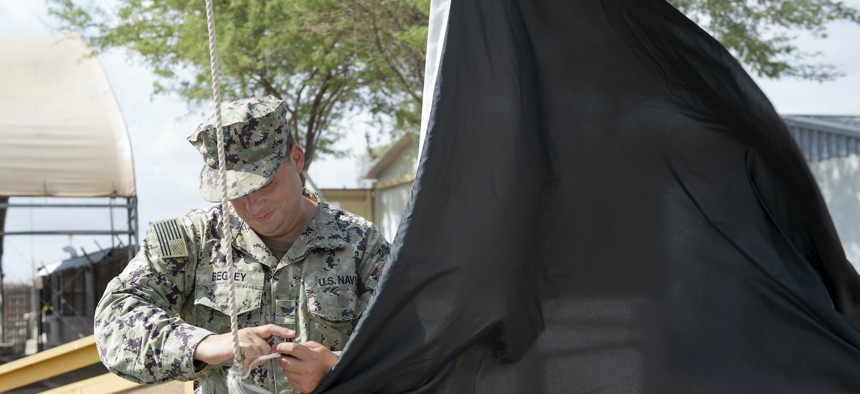PATRICK TUCKER
Source Link

The Pentagon's climate-adaptation chief said Friday that future U.S. troops deploy to environments several degrees hotter than today’s hottest places, they’ll need special gear to help them train and operate. And if the U.S. military can figure out how to operate in extreme heat, it could give them an advantage similar to the advent of night vision.
“If you go back 30, 40 years, we were concerned that we couldn't operate at night, and there was a significant investment in night vision. Now the United States military can operate day and night, all our assets,” said Richard Kidd, the deputy assistant defense secretary for environment and energy resilience. “We have a tremendous advantage in the fact that we're able to do that. Looking forward to a hotter world, we need to be able to operate in all temperatures. We need to be able to own the heat the same way that we now own night.”
Kidd, who spoke to Defense One in an interview that will air on Aug. 25 as part of the Defense One Climate Summit, has been warning that extreme heat is already beginning to affect military readiness.
For one thing, National Guardsmen in California are spending more and more time fighting wildfires. But Kidd also said it’s becoming harder to operate in many of the military’s most important training locales.
“Fort Benning [in Georgia] right now is a basic training post for the Army.” he said. “It is also the installation that currently suffers the highest number of heat casualties in the department, due to the training that goes along there and a combination of heat, humidity, and weather. So if you look to the future, we can predict that those ‘Category 5 days are going to triple by 2070.”
A Category 5 day, according to the U.S. Army Public Health Center, is one in which the wet bulb globe temperature index passes 90 degrees Fahrenheit.
“If you have 36 degrees Celsius—98 degrees Fahrenheit—and 100% humidity, the human body can no longer effectively cool itself. " It will start to shut down,” KIdd said. “So if we look towards the future, we're going to be asking our soldiers, Marines, sailors, and airmen to operate in…more extreme temperatures, hotter and more humid…And the fact that we do that poses a significant risk to their welfare. So we've already started talking about things like tactical cooling.”
That’s leading the Pentagon to ask questions like: “Do we need cooling vests? Do we need shelters and…places of cooling respite, whether it's on the battlefield, or on the deck of an aircraft carrier?”
He said that the Defense Department doesn’t have the luxury of staying indoors in the air conditioning. “One of the things about the Climate Adaptation Plan that the department published [last September] is, we want to be able to operate under all future conditions.”
The Defense Department can’t (and won’t) sacrifice military advantage to address climate change, Kidd said. But the Pentagon is investing heavily in tech to improve fuel efficiency across its operations, like kits to turn trucks into hybrid trucks, which Kidd projects could reduce fuel demand for the wheeled fleet by as much as 20 percent. They’re also investing in ambitious strategies that are just now emerging as realistic, like small, deployable nuclear reactors and solar power from space beamed to Earth.
Working with the Energy Department and other agencies, Pentagon leaders are investing in areas that might influence the commercial market, like small, local energy grids, or microgrids, which could be used at forward bases.
“We're about 30% of the microgrid market. So microgrids and large-scale battery storage…that's what excites me,” Kidd said. “We've got this dedicated [$700 million and growing] program to build out microgrids across our installations. We're going to chart the course for the country, build resilient installations that can withstand adversity, and be there to help the community and the nation when needed.”
That makes sense not only from an efficiency point of view but also a tactical one. Getting fuel to forward operating bases was a major problem in places like Afghanistan and Iraq, where soldiers often had to retrieve fuel drums under the threat of enemy fire. In a war against a smarter, better-armed adversary, fuel lines represent a major vulnerability.
“My counterpart of the Joint Staff, the J4, is propagating a joint operating concept around the fact that we are now in a contested logistical environment,” Kidd said. “If we look forward to a fight against a potential near-peer adversary, a lot of our fueling assets, like fueling ships at sea or tankers in the air, are now at risk in a way they've never been in the past. So we have to think comprehensively, not just about the soldier at the tactical edge, but about aircraft in flight and ships at sea. Across the board, we need to add redundancy and more sort of fuel handling capacity.”
No comments:
Post a Comment